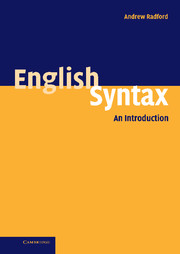2 - Words
Published online by Cambridge University Press: 05 June 2012
Summary
Overview
In this chapter, we look at the grammatical properties of words. We begin by looking at the categorial properties of words and at how we determine what grammatical category a given word belongs to (in a given use): in the course of our discussion we introduce some new categories which will not be familiar from traditional grammar. We go on to show that categorial information alone is not sufficient to describe the grammatical properties of words, ultimately concluding that the grammatical properties of words must be characterised in terms of sets of grammatical features.
Grammatical categories
Words are traditionally assigned to grammatical categories on the basis of their shared morphological and syntactic properties. The morphological criteria for categorising words concern their inflectional and derivational properties. Inflectional properties relate to different forms of the same word (e.g. the plural form of a noun like cat is formed by adding the plural inflection -s to give the form cats); derivational properties relate to the processes by which a word can be used to form a different kind of word by the addition of an affix of some kind (e.g. by adding the suffix -ness to the adjective sad we can form the noun sadness). Although English has a highly impoverished system of inflectional morphology, there are nonetheless two major categories of word which have distinctive inflectional properties – namely nouns and verbs.
- Type
- Chapter
- Information
- English SyntaxAn Introduction, pp. 28 - 56Publisher: Cambridge University PressPrint publication year: 2004



